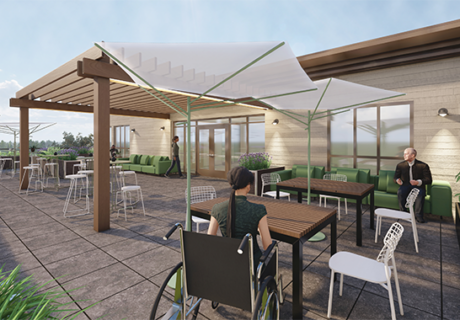Natural Wonder
For its 2017 Healthcare Design Competition, the International Interior Design Association (IIDA) introduced its Transformation and Innovation Award to recognize designers who are delivering cutting-edge healthcare designs. The organization found its winner in a pair of architects, Angela Muller and Marta Parra Casado, founders of Parra-Müller Arquitectura de Maternidades (Madrid), who call themselves “birth activists.”
Their firm’s entry—a natural birth unit at University Hospital HM Nuevo Belen in Madrid—won top honors in the Hospitals–Women’s category and was chosen for the inaugural innovation award for its modern design and thoughtful detailing that “still maintains a human connection,” says competition juror Tiana Lemons, healthcare studio leader at Orcutt Winslow (Nashville).
Adds juror Carol Doering, healthcare lead at IA Interior Architects (Washington, D.C.), “The designers took the birth experience and created an interior that expressed, in the built environment, the organic human form.”
The idea for a natural birth unit, which will offer women the opportunity to have a natural birth experience in a calming, non-institutional setting within a hospital, was developed after the firm began working with midwives and obstetricians to learn about the physiological birth process.
“Our design is based on the conviction that birth doesn’t necessarily have to be a medical act in the first place,” Muller says. “So we design for a normal birth, putting a big emphasis on privacy and a relaxing environment, but we also make sure that everything necessary is within reach if medical attention is needed.”
The opportunity to bring this vision to life came in 2011 when the firm began working with HM Hospitales, a healthcare group in Madrid, which had recently purchased Clinica Belen, an established hospital focused on women’s healthcare. The organization wanted to expand its market reach and attract new patients and began updating some of the hospital’s more traditional birthing rooms.
The firm shared its idea for the addition of a natural birth unit as an option to further differentiate the facility, and soon an empty wing on the ground floor was transformed into a 1,830-square-foot unit that opened in October 2015 with three natural birthing rooms, a resuscitation area, and a rest area for midwives.
HM Hospitales’ natural birthing rooms are divided into four zones: an entry with hanging Japanese screens to provide privacy between the door and the rest of the room; a bed and movement zone, which includes different furniture pieces to support women in different birthing positions; a birth pool zone, with a tub to provide the option for a water birth; and a private bathroom with a large shower space.
A striking feature within the room is a fluid sculptural element that divides the bed and wet areas with integrated storage for personal belongings, as well as a curved counter, sink, and low seat to support women or midwives during the labor and delivery process. “Most women during dilation search for support when they are in standing positions,” Muller says. “Being able to hold onto this furniture element allows the mother to rest her arms while the rest of her body is free to move.”
Clinical tools are incorporated into the space in thoughtful ways that support the room’s calming setting, with large medical equipment and linens stored in the sculptural room divider and medical gases concealed inside a decorative wooden element on the headwall.
“This design helps to create an environment for the experience,” Doering says. “It isn’t just about going to a room to have a baby, it’s about the experience—mood, ambience, the non-clinical natural process of a mother giving birth to her baby.”
For a list of all the winners, click here.









